This Chukar was hungry and he had a strong penchant for flowers. In fact he really stuffed himself on them.
All images are presented in the order they were taken.
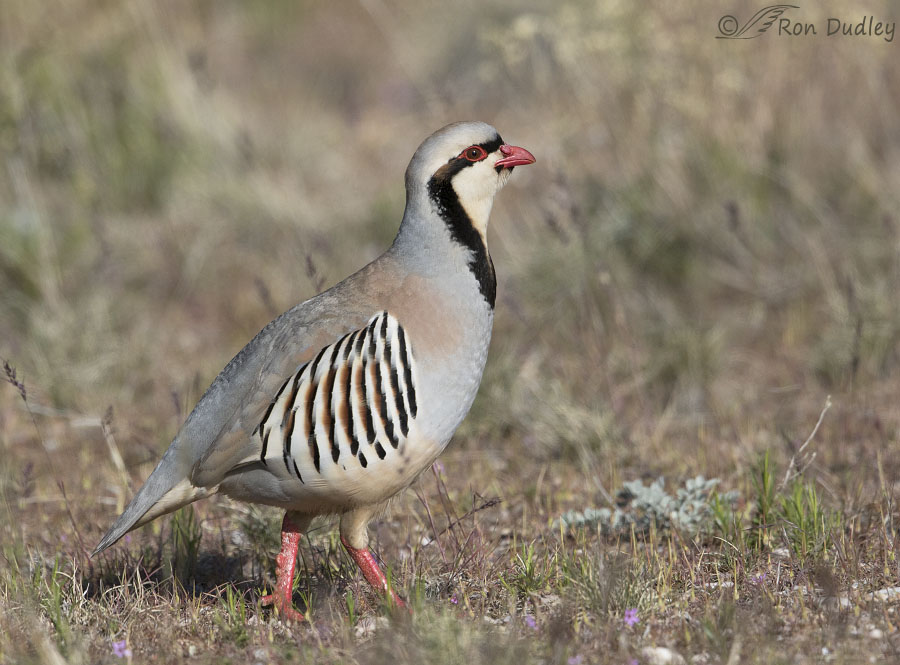
Three days ago on Antelope Island we found two presumed male Chukars fighting near the Frary Peak trailhead. By the time I got my pickup turned around and into position the fighting was over and this one was far more interested in filling its belly than it was in confrontation.
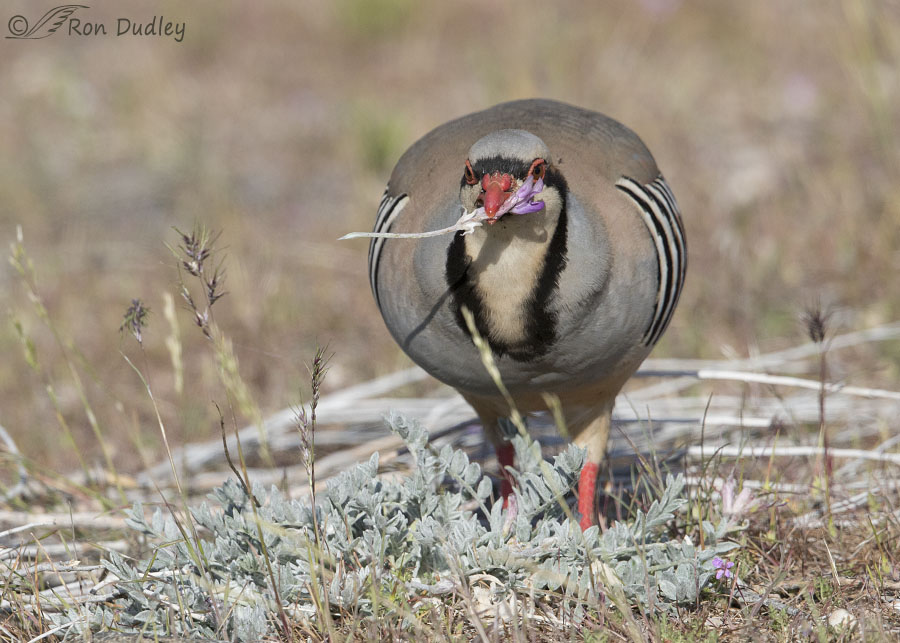
All he was interested in eating was purple flowers from a particular type of plant (I don’t know the species).
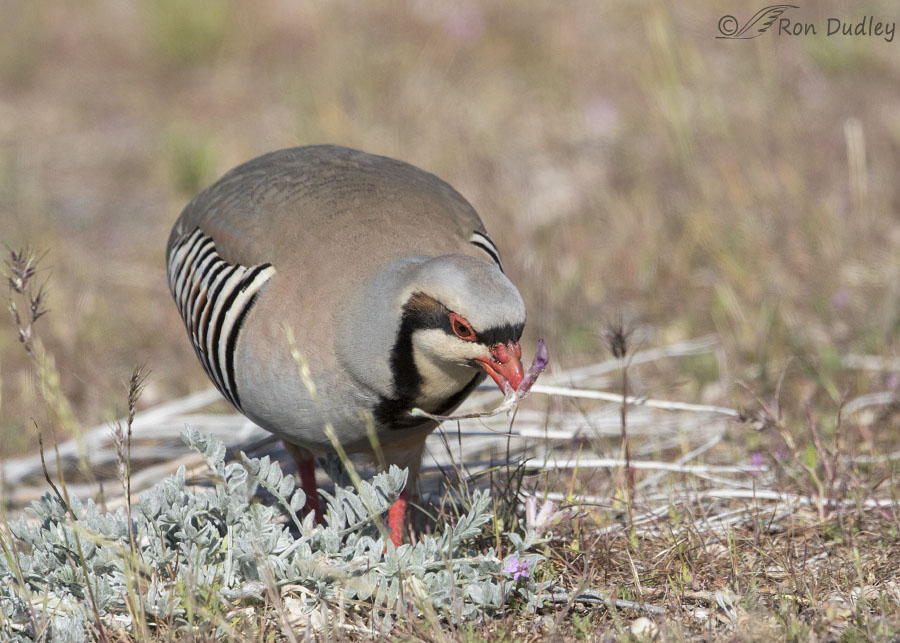
And he was really gobbling them down as he moved from plant to plant. It was frustrating for me as a photographer because he was usually facing me while he was eating them so I had a very difficult time getting any light in his eyes. And it was late enough in the morning that the sun angle didn’t help with that problem.
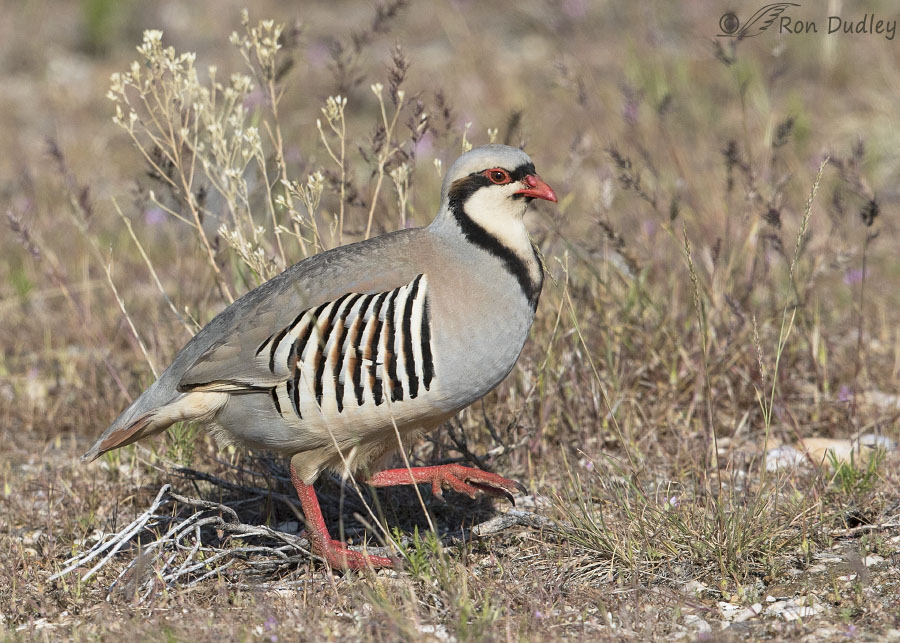
When he was through with one plant he’d walk around and look for another of the same species.
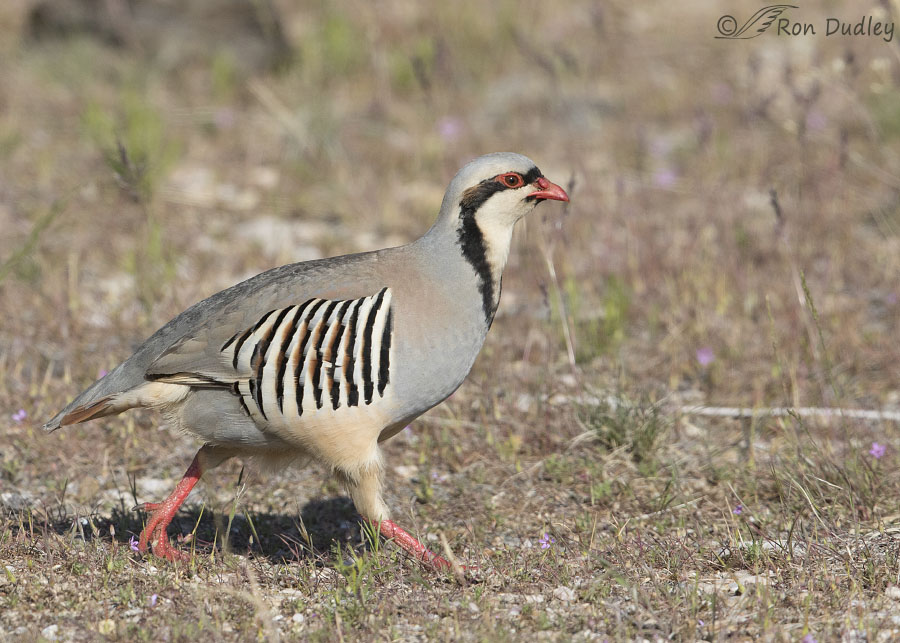
Twice he actually ran from plant to plant, as if he was afraid the other nearby Chukar would beat him to it.
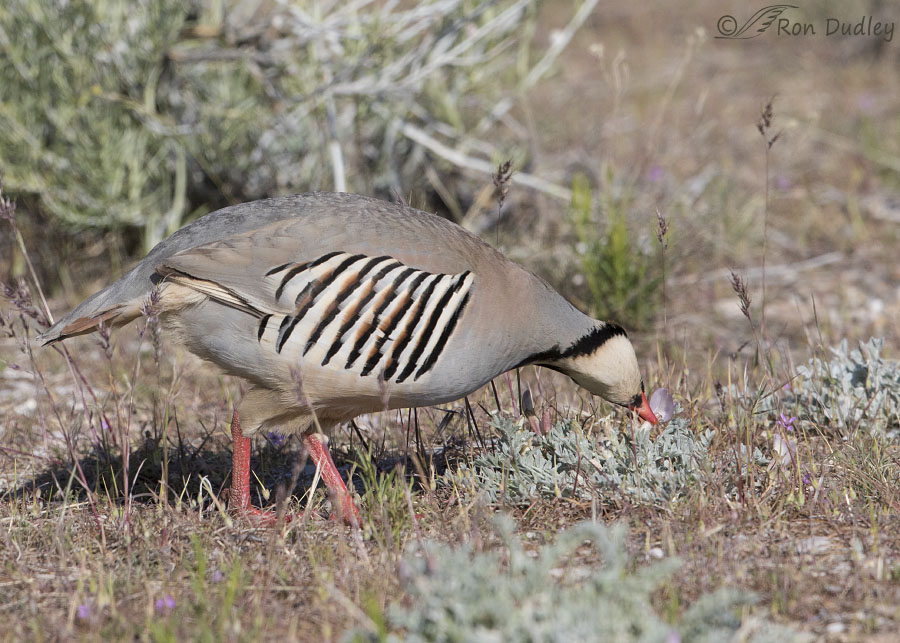
I noticed several times that he would twist his head in order to grasp the flowers and pluck them which made for a rather unusual perspective on a bird of any kind.
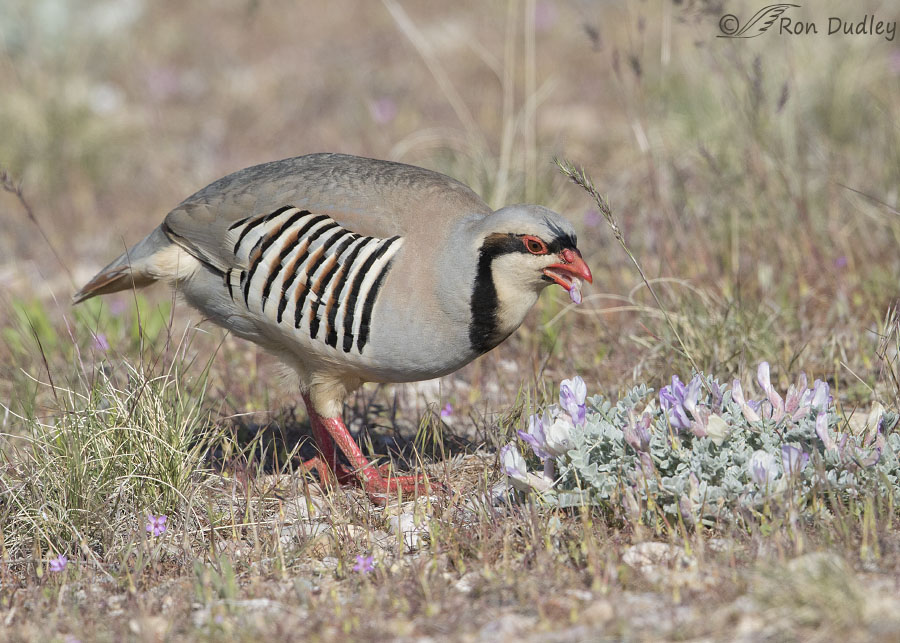
Some of the plants had only a flower or two and others were loaded with them but he had no interest in plants of any kind other than this (I’d be interested in what species it is if any of my readers are familiar with it).
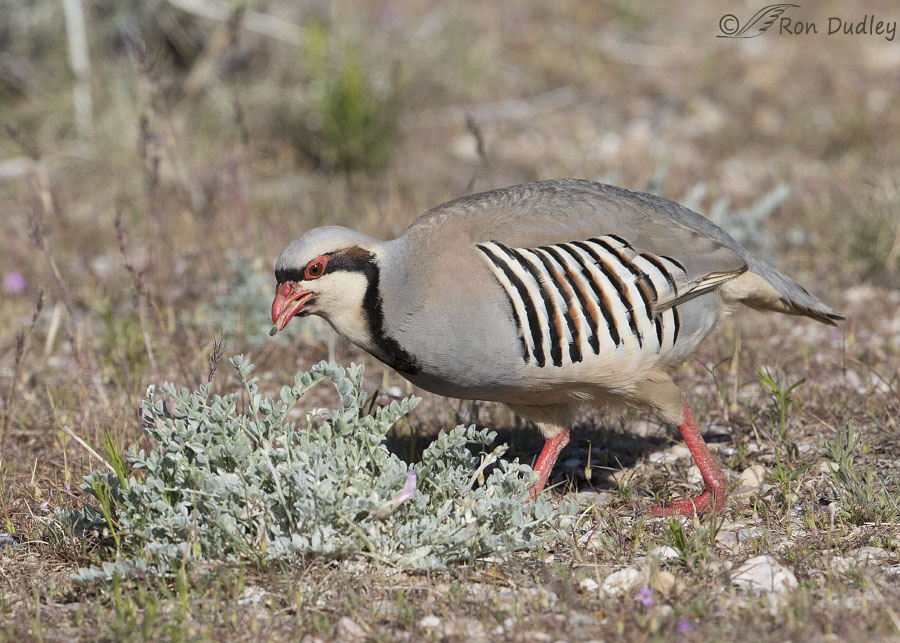
Except for once he was always facing north while he was eating but this time he turned around and faced south. Even though we can’t see the flower in his beak very well I decided to include this shot because that change of direction gave me my only photos of him eating that included a catch light in his eye.
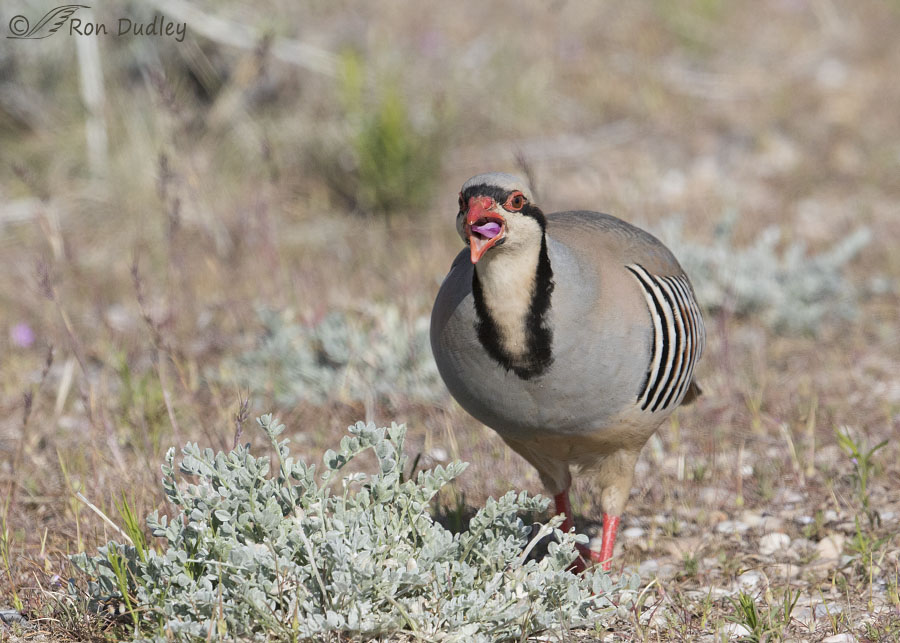
This isn’t a great shot but I thought the perspective on the flower going down his throat was an interesting one.
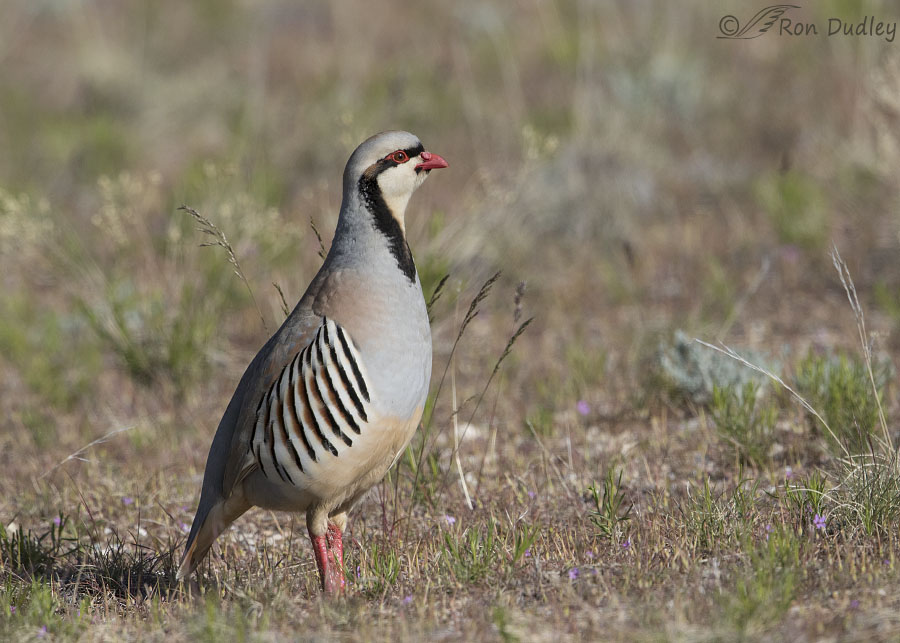
Just before I left these birds he posed nicely once again.
I enjoy seeing Chukars in their fresh spring duds. Because of molt and/or “wearing to dark” Chukars look pretty scruffy for much of the year but in fresh plumage I think they’re classy looking birds.
Ron
Notes:
- I haven’t included my image techs this morning because they were fairly inappropriate for the situation. These birds were fighting when I approached them and my initial intention was to try to capture the action which would require very high shutter speeds. But when they didn’t fight I simply forgot to adjust my camera settings. Most of these photos were taken at 1/4000-1/5000, f/6.3, ISO 640.
- My presumption that this bird is a male is based on the following from Birds of North America Online (they make no mention of females fighting). “Once birds are paired and establish territory, male becomes aggressive and fights with other males that enter nesting territory. (Mackie and Buechner) indicated that rather than strictly defending nesting area, male simply repels other males from vicinity of female.”


What a wonderful series (she said, struggling with the ridiculously redundant thing again). Like the others, I really like the one where he’s twisting the flower and the down-the-hatch shot!
Chukars are great quarry for falcons of most any sort. I’ve watched several spirited hunts. And they taste good, too.
Oh, did I tell you I have quail nesting in my roses? I put water out for them, filling the pan with pebbles so the little ones can’t drown. They’re bad about that!
The Beagle Boys are back!!! Woo Hoo and happy dances from here.
Love the ‘down the hatch’ shot in particular, but they are all a joy to see. Thank you.
I thought of you when I posted this, EC – knowing how much you enjoy Chukars. It’s been a while since I posted any.
I enjoy rather a lot of ‘your’ birds. And look forward to them returning perhaps nearly as much as you do.
My herbalist friend at herbmother.com says it looks like a variety of vetch. I think Judy bailed it with her link.
Looks like this is the plant………. http://www.unps.org/plant%20data%20base/plant%20sheets/utladyfing.html
Yup, looks like it might be.
I kind of like seeing the pictures of the Chukars from a different angle. Yes there are in the Big Horn Basin side of the BigHorn Mountains. Dad use to go hunting for a few of them back in the 1950s. They were like chicken meat but a little greasy. Nice to see them eating flowers.
I know that some hunters love to eat them, even though they’re an extremely difficult quarry for them.
Maybe another name for the plant, Locoweed, explains the dash around to get thew most. Great series and beautiful pictures.
I’ve heard about locoweed since I was a kid. Didn’t know it was this one though.
Beautiful shots of a beautiful bird. Interesting that he wanted just the one type of flower. I don’t think I’ve ever been aware that any bird eats flowers. Wish I could help you with the species, but the plant is totally unfamiliar to me. I’ll also be interested to know what it is.
Thanks, Susan. Several readers have identified it below as a milkvetch.
A fun series of him running from station to station at the buffet! I especially like the plucking shot in which his little “soul patch” is showing. I never knew they had those dark feathers under there. The second-to-last shot — down the hatch! — is pretty cool too. Thanks for braving the noseeums to get these shots!
Those gnats were simply dreadful out there that morning, Marty. I don’t think I’ve ever seen them worse and I’ve been going to the island for 10 years now.
You’re a better man than I am, Gunga Din. I would have said *censored* and come home!
I did say “censored”, uncounted times. Didn’t seem to help much though…
Very interesting bird, attractive in it’s own right. Makes me wonder what those flowers taste like with it running from plant to plant. A side note… A few years ago I drove to Montana and down to Arizona along two lane roads mostly. Along the way I stopped frequently taking pictures of wildlife and wildflowers; that looks like Early Purple MilkVetch , Astragalus- possibly shortianus, but in the Fabaceae family.
A side note… A few years ago I drove to Montana and down to Arizona along two lane roads mostly. Along the way I stopped frequently taking pictures of wildlife and wildflowers; that looks like Early Purple MilkVetch , Astragalus- possibly shortianus, but in the Fabaceae family.
Thanks, Kathy. Several readers agree with you that it’s a milkvetch.
so Chukars are stuffed with flowers, not inflated! Who knew??? Love idea, especially if the flowers are invasive….
They do appear to be stuffed with something…
What a wonderful series Ron! Love it!
Charlotte
Thank you, Charlotte.
Nice photos Ron. A very colorful bird, and one I have never seen. Just Googled and find that they were brought here from the Middle East and Southern Asia as game birds and introduced into arid regions of the west. Arizona Game and Fish lists them as game birds in Northern Arizona. Possibly we have them, but probably more in the Flagstaff area up through the Grand Canyon and into Utah. Will be on the lookout for them though.
Everett Sanborn, Prescott AZ
Everett, They’ve been introduced to many states, originally for hunting purposes. On Antelope Island they breed wild.
I think the plant is Astragulus purshii or wooly pod milkvetch. Beautiful photos and interesting behavior you caught. Thanks.
Thank you for the ID, Brett.
Thanks for the photos! The plant is a type of milkvetch, I think. Look at this website: https://issuu.com/usuextension/docs/wildflower_guide_2013
I think you’re right, Nina. Thank you.
The plant is a legume, probably in the Pea subfamily, but I don’t know the species.
Thanks, Pam. Mia thought it was in the pea family too.
Fun! Chukars are pretty little birds for sure. Their sleek coat this time of year almost looks painted on. Don’t know what that flower is but I see some other little purple/pink flowers that look suspiciously like a weed of some sorts that’s shown up here in the past few years……….
Their sleek coat this time of year almost looks painted on. Don’t know what that flower is but I see some other little purple/pink flowers that look suspiciously like a weed of some sorts that’s shown up here in the past few years………. 
Thanks, Judy. I suspect that plant might be an invasive. So many of them are these days…
This a nice native plant of the shrub steppe. Great series of pictures! We have chukars in Central Washington. My dad used to hunt them back in the 50s and 60s.
Good to know it’s native, Jan. It must taste good too, at least to Chukars…